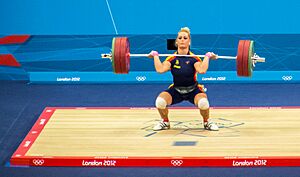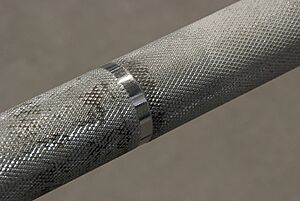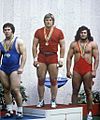Olympic weightlifting facts for kids
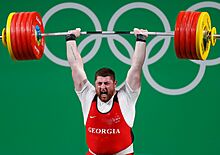
Olympic weightlifter Lasha Talakhadze lifting 258 kg at the 2016 Olympic Games in Rio, Brazil
|
|
| Highest governing body | International Weightlifting Federation |
|---|---|
| First developed | Ancient Greece |
| Characteristics | |
| Contact | No |
| Mixed-sex | No |
| Type | Power sport |
| Equipment | Barbells, weight plates, collars, chalk, tape, heel-elevated shoes, belt, knee sleeves, wrist wraps |
| Presence | |
| Country or region | Worldwide |
| Olympic | Men: 1896, 1904, 1920–present; Women: 2000–present |
| World Games | Women: 1997 |
Weightlifting (also called Olympic weightlifting) is a sport where athletes lift a heavy bar with weights from the ground over their head. The goal is to lift the heaviest weights possible.
Athletes use two special ways to lift the barbell overhead. The snatch is a wide-grip lift. The athlete lifts the weight over their head in one smooth movement. The clean and jerk is a two-part lift. First, the weight is lifted from the ground to the front of the shoulders (the clean). Then, it's lifted from the shoulders to over the head (the jerk).
Each weightlifter gets three tries for the snatch and three tries for the clean and jerk. The snatch is always done first. An athlete's final score is the total of their best successful lift in the snatch and their best successful lift in the clean and jerk. This score is measured in kilograms. Athletes compete against others who are similar in body weight.
Weightlifting is an Olympic sport. It has been part of almost every Summer Olympic Games since 1920. While the sport is officially "weightlifting," people often say "Olympic weightlifting." This helps tell it apart from other sports that involve lifting weights. These include powerlifting or strongman events. The snatch and clean and jerk are known as the "Olympic lifts."
Olympic weightlifting tests both strength and how fast you can move (explosive power). The Olympic lifts are done quickly. They also need more flexibility and a bigger range of motion than other lifts. Many athletes in other sports use these lifts to train for power and functional strength.
Contents
How Weightlifting Competitions Work
Weightlifting competitions happen at local, national, and international levels. The International Weightlifting Federation (IWF) is the main group that runs the sport worldwide. They also organize the World Weightlifting Championships every year.
The Main Lifts
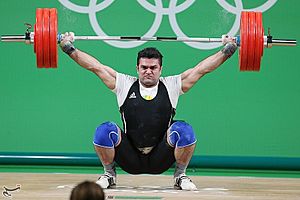
The snatch is a lift where the athlete pulls the barbell from the floor to over their head in one quick motion. The lifter uses a wide grip on the bar. They pull the bar up and quickly bend their knees to get under it. They usually end up in a deep overhead squat position, holding the bar overhead with straight arms. To finish the snatch, the lifter stands up straight while still holding the barbell overhead. The snatch needs very good balance.
The clean and jerk is a lift with two parts. The athlete first lifts the barbell to their shoulders (the clean). Then they lift it from their shoulders to over their head (the jerk).
To do the clean, the lifter uses a shoulder-width grip. They pull the bar off the floor. Then they quickly bend their knees and arms to get their body under the bar. They "catch" the bar on the front of their shoulders. This is usually done in a deep front squat position. The lifter finishes the clean by standing up straight with the barbell on their shoulders.
Next comes the jerk. The lifter uses a powerful jump to push the barbell overhead. They often split their feet, with one foot forward and one back. This is called a split jerk. The jerk is complete when the lifter brings their feet together and stands straight with the barbell held overhead.
There used to be a third lift called the clean and press. This lift was part of competitions from 1924 to 1972. It involved a clean, followed by pushing the bar overhead without bending the legs or moving the feet. It was stopped because it was hard for judges to tell if athletes were doing it correctly.
Weight Categories
Athletes compete in groups based on their body mass. These groups are called weight classes. The IWF updated the weight categories in 2018. They decided which ones would be used at the 2020 Summer Olympics.
IWF Men's Weight Classes:
- 55 kg (121 lb)
- 61 kg (134 lb)
- 67 kg (148 lb)
- 73 kg (161 lb)
- 81 kg (179 lb)
- 89 kg (196 lb)
- 96 kg (212 lb)
- 102 kg (225 lb)
- 109 kg (240 lb)
- 109 kg and over (240 lb+)
For the Paris 2024 Olympics, only five men's weight classes were chosen:
- 61 kg, 73 kg, 89 kg, 102 kg and over 102 kg.
IWF Women's Weight Classes:
- 45 kg (99 lb)
- 49 kg (108 lb)
- 55 kg (121 lb)
- 59 kg (130 lb)
- 64 kg (141 lb)
- 71 kg (157 lb)
- 76 kg (168 lb)
- 81 kg (179 lb)
- 87 kg (192 lb)
- 87 kg and over (192 lb+)
For the Paris 2024 Olympics, five women's weight classes were chosen:
- 49 kg, 59 kg, 71 kg, 81 kg and over 81 kg.
Competition Rules
In each weight class, lifters compete in both the snatch and the clean and jerk. Awards are usually given for the heaviest weight lifted in each lift. There is also an award for the total combined weight of both lifts.
The lifter who wants to try the lowest weight goes first. If they fail, they can try that weight again or a heavier one. The barbell is made heavier step by step throughout the competition. Weights are added in 1-kilogram steps. If two athletes lift the same weight, the one who lifted it first gets a higher rank.
The snatch event happens first, then there's a short break. After that, the clean and jerk event takes place. Two side judges and one head referee decide if a lift is "successful" or "failed." They use a lighting system: a white light means "successful," and a red light means "failed." Two "successful" lights are needed for a lift to count.
If a lifter doesn't successfully complete at least one snatch and one clean and jerk, they don't get a total score. This means they don't finish the competition.
Local Competition Awards
At local competitions, a "Best Lifter" award is often given. This award goes to both the best male and female lifters. It's based on a special math formula called the "Sinclair coefficient." This formula helps compare lifters of different body weights and genders fairly.
Even if a lifter in a heavier weight class lifts the most total weight, a lighter lifter might still win "Best Lifter." This happens if their lift is much heavier compared to their own body weight, according to the Sinclair formula.
Weightlifting Equipment
The Barbell
Olympic weightlifting uses a steel bar called a barbell. It has spinning ends where rubber-coated weight plates are put on. These spinning ends are important because they make it easier to lift the bar quickly. Without them, the bar would be harder to control and could cause injuries.
A men's Olympic barbell weighs 20 kg (44 lbs). It is 2200 mm long and 28 mm thick. A women's Olympic barbell weighs 15 kg (33 lbs). It is 2010 mm long and 25 mm thick. The space between the weight plates is the same for both bars (1310 mm). The rough part of the bar for gripping is called the knurling. Men's bars have knurling in the middle, but women's bars do not. The IWF checks and approves all barbells used in competitions.
Bumper Plates
The weight plates are usually called "bumper plates." They are covered in rubber. This rubber coating allows the weights to be dropped safely after a lift, whether it's successful or not. Bumper plates weigh between 10 kg and 25 kg. They come in steps of 5 kg.
Olympic bumper plates have specific colors:
- 10 kg plates are green.
- 15 kg plates are yellow.
- 20 kg plates are blue.
- 25 kg plates are red.
Small Iron Plates
Smaller iron plates can be added to the bar for tiny weight increases. These plates also have specific colors:
- 0.5 kg and 5 kg plates are white.
- 1 kg plates are green.
- 1.5 kg plates are yellow.
- 2 kg plates are blue.
- 2.5 kg plates are red.
Notice that the colors for these smaller plates match the colors of the larger bumper plates (e.g., 1 kg and 10 kg are green).
Collars
Special clamps called collars are used to hold the weight plates onto the bar. Each collar weighs exactly 2.5 kg.
Singlet
Lifters usually wear a tight, one-piece suit called a singlet. They can choose to wear a T-shirt underneath it.
Belt
A weightlifting belt can be worn around the waist. It can be up to 120 mm wide. The belt helps support the lifter's core muscles.
Chalk
Olympic lifters often use chalk on their hands before lifting. The chalk helps keep their hands dry. This stops the bar from slipping during the lift.
Tape
Lifters often use tape on parts of their body that might rub against the bar. Tape is most commonly used on the thumb. Taping the thumb helps prevent blisters. It also makes the hook grip (a way of holding the bar) less painful.
Lifters also tape their wrists. This helps keep their wrists stable during lifts. It can prevent the wrist from bending too much. However, using tape too much can sometimes make the wrist weaker over time.
Shoes
Weightlifting shoes are very special. They usually have a raised heel, about 0.5 to 1.5 inches high. They also have straps across the top of the foot. The raised heel helps the lifter stay upright when they catch the bar. It also lets them squat deeper under the bar. The soles of the shoes are very stiff. This helps them stay stable under heavy weights. The front part of the shoe is flexible. This allows the lifter to go up on their toes during the "jerk" part of the lift.
Modern weightlifting shoes often have hard plastic heels. Some older-style shoes use wood heels, which are also hard.
Knee Sleeves
Some weightlifters wear knee sleeves. These give support to the knee joints. They can also help the lifter stand up from a deep squat.
Wrist Wraps
Wrist wraps are often used to give extra support to the wrist joint.
Related pages
Images for kids
-
The 110 kg division weightlifting winners at the 1980 Summer Olympics, held in Moscow
See also
 In Spanish: Halterofilia para niños
In Spanish: Halterofilia para niños
- Weightlifting at the Summer Olympics
- List of world records in Olympic weightlifting
- List of Olympic records in weightlifting
- List of Olympic medalists in weightlifting
- Powerlifting
- Power training
- Paralympic powerlifting


